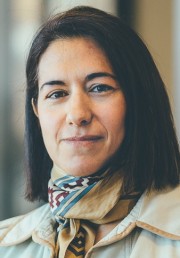
Tessy Cerratto Pargman
Associate professor in Human computer interaction at the Department of Computer and Systems Sciences (DSV) at Stockholm University
- +46 8 161698
- [email protected]
“In a learning context, technology is helping us to think, to reflect on how to cooperate, how to write texts. Technology should challenge the learner – technology itself will not facilitate learning,” says Tessy Cerratto Pargman.
Teresa (Tessy) Cerratto Pargman was born and raised in Buenos Aires, Argentina, where she received her undergraduate education in psychology. Then she went to France on the one-year scholarship at the master level, followed by graduate studies in cognitive psychology at the Paris VIII University. She moved to Sweden in 2000 – first to a post as a research assistant at KTH and then a lectureship at DSV where she is now an associate professor.
She sees great potential in the new technologies in terms of learning. But for her part, it is not the technology itself that is the main thing – but what you make of it based on needs and desired results. Currently she is working in the project “Places” that started in January 2013, that deals with mobile technology integration in elementary school. She is studying how it works and does not work, what is required of teachers and of the school and what it means for learning.
“There are so many myths about technology – very often it is perceived as something positive and modern, as the next one solution, “a cure” for all the problems that our education system has. But I do not see the technology in TEL * area as a solution for learning but as a mirror of our practices on teaching and learning. Technology captures our knowledge; savoir-faire and savoir-être in a rational way that I think are interesting to study,” she says.
An important aspect of her research is to develop tools that challenge learning. For example, Teresa helped to develop language software for the learning of Swedish as a second language. Most important for the researchers was to develop an environment with different types of tools that enable users to examine their language texts, but also to think, to reason about language writing by visualizing different classes of words, spelling, tense, congruence, word order, prepositions. The idea is not to focus on the tools that fix the errors, but to develop tools that challenge the user, the learner, to consider the language and not just produce it.
Related links
- Tessy Cerratto Pargmans blog
- Design for learning, DEL, at Stockholm university
- Research interview with Tessy Cerratto Pargman
Tags
Next Crosstalks august 20, 6:00 PM CET

